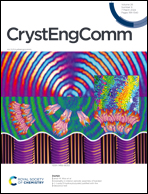Scaffold-directed growth of metal halide perovskite hopper crystals†
Abstract
Here we present a solution-based method of growing three-dimensional flower-shaped metal halide perovskite crystals by drop casting solutions of FAxMA1−xPbyI1+2y precursors (FA = formamidinium, MA = methylammonium) on close-packed monolayers of titanium dioxide (TiO2) colloidal particles. The colloidal films directed perovskite crystallization during solvent evaporation, with crystals first nucleating within the confining interstitial sites between colloidal particles and growing perpendicular to the substrate surface. When growth proceeded above the colloidal film, the crystals blossomed outwards to form flower-shaped hopper crystals with a hierarchical 3D structure. The crystal shapes ranging from circular discs to pointed snowflakes were achieved by varying the solution pH and precursor composition. Structural complexity in these crystals was observed across multiple length scales – X-ray diffraction patterns and spatially-resolved photoluminescence mapping revealed three polymorphs present for all compositions tested: two bulk phases and one surface phase. These structures exhibit broad areas for light absorption but small contact areas with the underlying substrate for charge transport, which may be useful for optoelectronic devices, such as 2D photodetectors.



 Please wait while we load your content...
Please wait while we load your content...